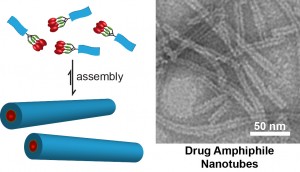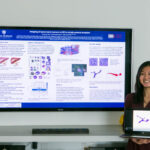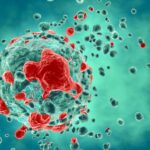Self-assembling drug molecules could fight cancer

A popular method of targeted drug delivery for anti-cancer drugs involves doping another material with the desired pharmaceutical to obtain better targeting efficiency to tumor sites. The problem with this method, researchers have discovered, is that the quantity of drug payload per delivery unit can vary widely and that the materials used for delivery can have toxic side effects.
But what if you could turn the drug molecule itself into a nanoscale delivery system, cutting out the middleman completely?
In the image above:
TEM image of nanotubes formed by self-assembly of an anticancer drug amphiphile. These nanotubes possess a fixed drug loading of 38% (w/w). Image from Cui Lab.
Using the process of molecular self-assembly, that is what Honggang Cui, an assistant professor in the Department of Chemical and Biomolecular Engineering at Johns Hopkins University, is attempting to do. His efforts have netted him the prestigious Faculty Early Career Development (CAREER) Award from the National Science Foundation. Cui, an affiliated faculty member of the Johns Hopkins Institute for NanoBioTechnology, will receive the $500,000 award over five years.
Cui explained that a current method of delivering anti-cancer drugs is to enclose them in a nanoscale carrier made of natural or synthetic materials, but this method presents several challenges. “The amount of drug loaded per carrier is very much limited and varies from batch to batch. Even in the same batch, there is a drug loading variation from carrier to carrier. Additionally, the carrier material itself may have toxic side effects,” he said.
Cui’s research seeks to eliminate the need for the carrier by coaxing the drug molecules themselves to form their own carrier through the process of self-assembly. His team is developing new molecular engineering strategies to assemble anti-cancer drugs into supramolecular nanostructures.
“Such supramolecules could carry as much as 100 percent of the drug, would possess a fixed amount of drug per nanostructure and would minimize the potential toxicity of the carrier,” Cui said.
To learn more about research in the Cui lab go to http://www.jhu.edu/cui/
Latest Posts
-
 Q&A with PSON Intern Jocelyn Hsu
August 19, 2021
Q&A with PSON Intern Jocelyn Hsu
August 19, 2021
-
 Start Up Founders from Johns Hopkins Aim to Stop Spread of Cancer
August 3, 2021
Start Up Founders from Johns Hopkins Aim to Stop Spread of Cancer
August 3, 2021
-
 Protein Appears to Prevent Tumor Cells from Spreading Via Blood Vessels
July 15, 2021
Protein Appears to Prevent Tumor Cells from Spreading Via Blood Vessels
July 15, 2021


